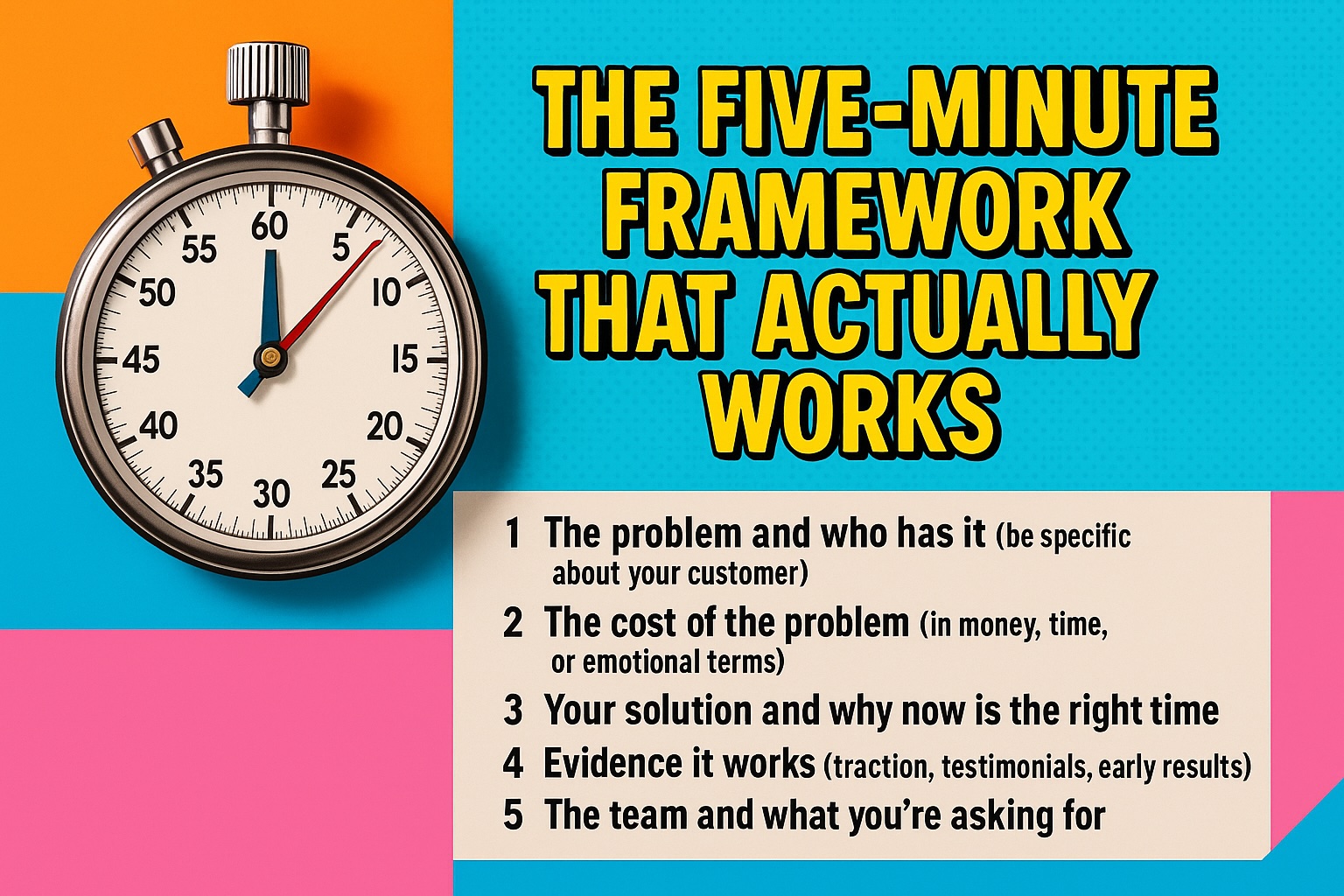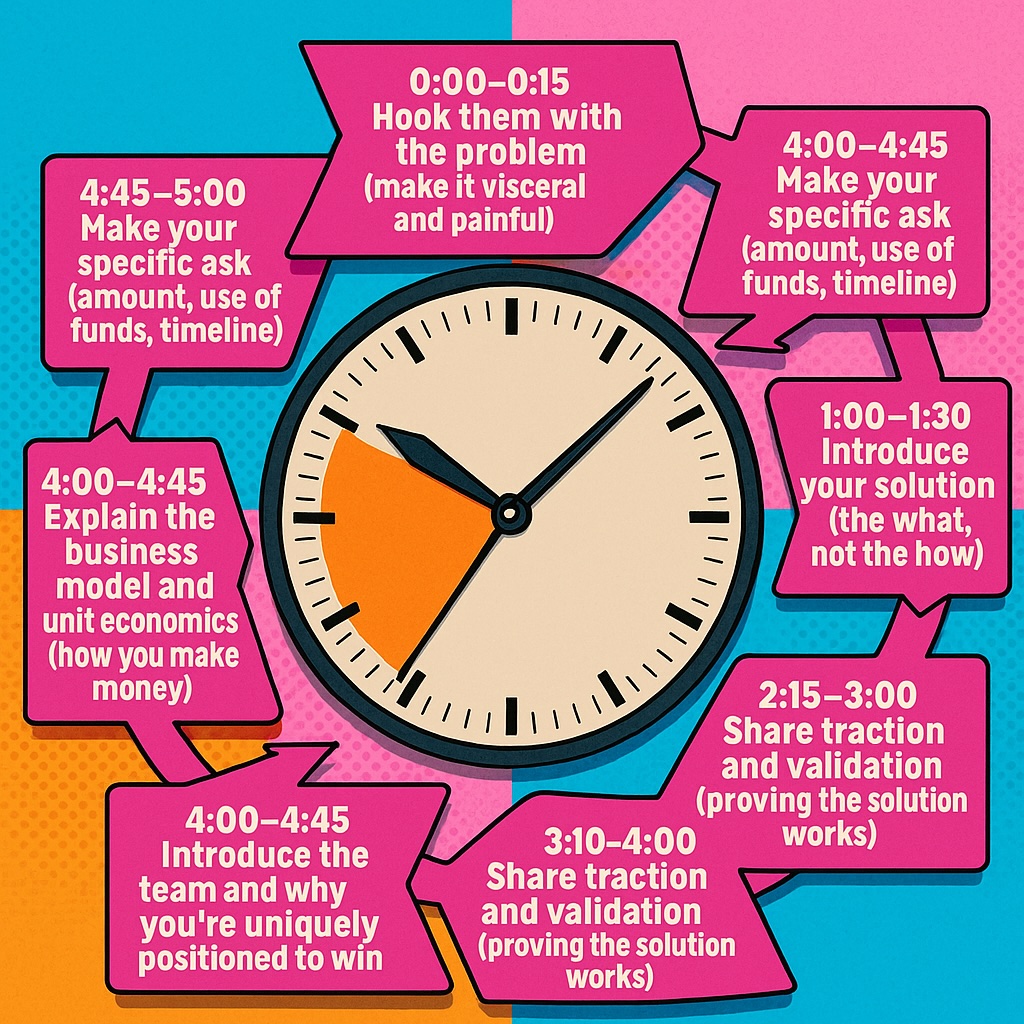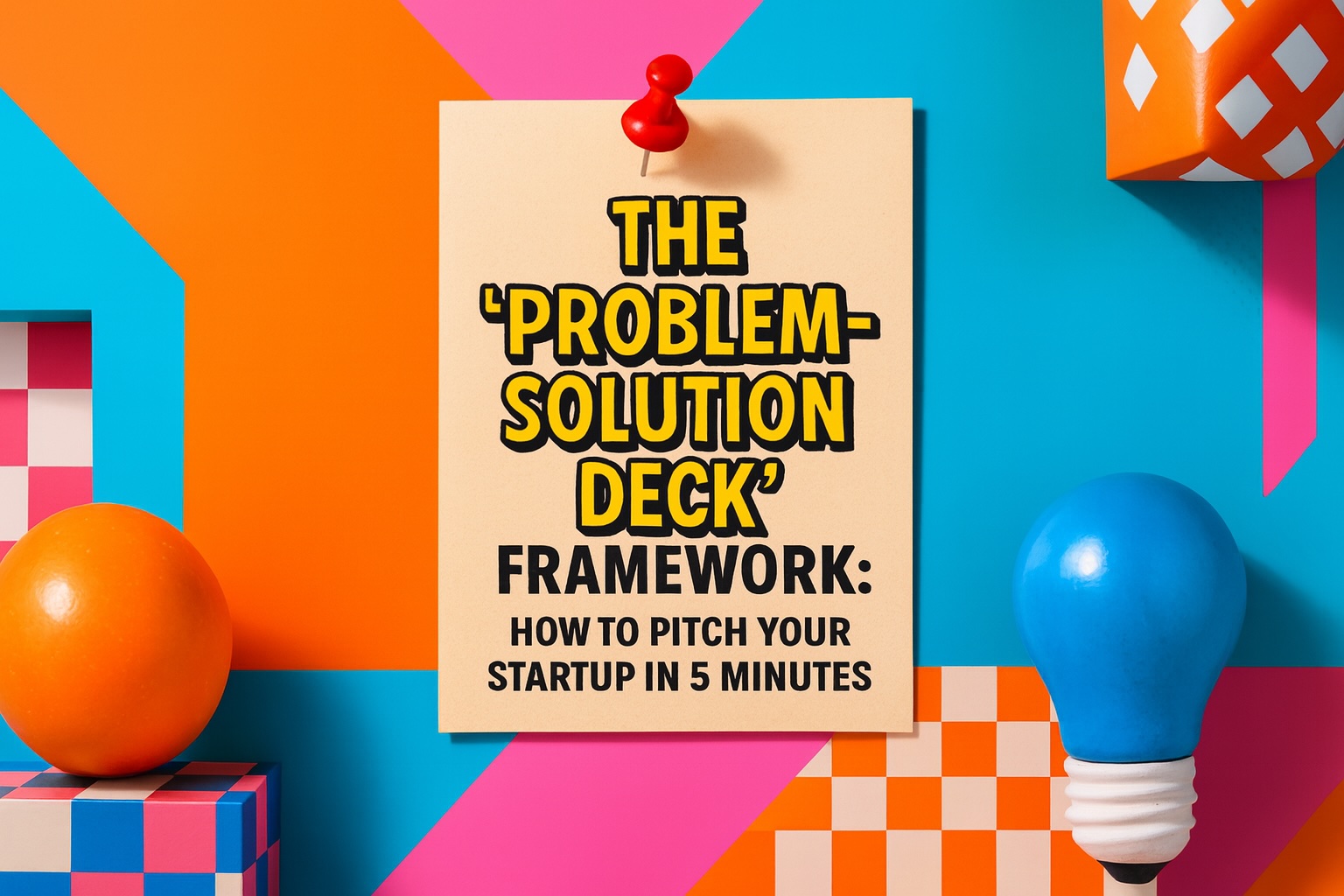The 'Problem-Solution Deck' Framework: How to Pitch Your Startup in 5 Minutes
You've got five minutes to convince someone to give you their money. No pressure. While most founders fumble through rambling pitches that would make a Victorian novelist blush, smart entrepreneurs know the secret: nail the problem first, then dazzle with your solution.
The Brutal Truth About Investor Pitches: Why Most Founders Crash and Burn in Five Minutes Flat
Let's be honest. That pitch deck you've been labouring over for weeks? The one with the fancy animations and the market size slide that makes your addressable market look like the GDP of a small country? It's probably rubbish. Not because you're incompetent (though the jury's still out on that), but because most of us founders are pathologically incapable of getting out of our own way. We fall in love with our solutions before properly articulating the problems they solve. Having crashed and burned in front of investors myself, I can assure you there's a better way—one that doesn't involve watching venture capitalists check their watches three minutes into your "revolutionary" presentation.
The Problem with Your Problem Slide
The most fatal flaw in startup pitches isn't the dodgy financials we've all massaged (oh come on, we've all done it). It's the inability to articulate a problem worth solving. Your clever solution means absolutely nothing if you haven't established that there's a bleeding, gaping wound in the market that desperately needs your particular bandage.
When I pitched my first business, I spent 80% of my deck talking about our exquisite product and barely a sentence on why anyone should care. The investors' eyes glazed over faster than a doughnut at Krispy Kreme. The truth is, investors don't fund products—they fund solutions to painful, expensive problems experienced by people with money and motivation to solve them.
Your problem slide shouldn't just state the obvious. "People find it hard to book restaurants" isn't a problem statement—it's a yawn inducing observation. "Urban professionals waste 45 minutes per week trying to book restaurants, resulting in £1.2 billion in lost productivity annually" is getting warmer. Now we're talking about something that hurts enough to justify a solution.
The Solution Slide: Less is Catastrophically More
After nailing your problem (and please, for the love of all things holy, nail your problem), your solution needs to be crystal clear. Not "we're building an AI-powered, blockchain-enabled, cloud-native platform with proprietary algorithms." That's not a solution—that's a buzzword bingo card.
Your solution should be articulated in under 15 seconds. If you can't explain it to your grandmother after she's had two sherries at Christmas lunch, it's too complicated. "We've built a mobile app that lets restaurants fill last-minute cancellations by offering dynamic discounts to nearby diners" is infinitely better than three slides of technical architecture that no one cares about.
Remember: complexity doesn't impress investors. Clarity does. The most successful pitch I ever gave took my original 18-slide deck and ruthlessly amputated it down to 7 slides. It was the presentation equivalent of Marie Kondo asking "does this spark funding?"

After watching hundreds of pitches (and delivering some spectacularly terrible ones myself), I've developed a problem-solution framework that works in exactly five minutes. It's not revolutionary, but unlike your AI-powered dog walking service, it actually delivers on its promise.
- Minute 1: The problem and who has it (be specific about your customer)
- Minute 2: The cost of the problem (in money, time, or emotional terms)
- Minute 3: Your solution and why now is the right time
- Minute 4: Evidence it works (traction, testimonials, early results)
- Minute 5: The team and what you're asking for
This structure forces you to focus on what matters. It prevents you from wandering into the weeds of your tech stack or waxing lyrical about the "journey" that led you to start the company. (Trust me, no one cares about that vision you had while on holiday in Bali).
The Slides You Actually Need (And None of the Ones You Don't)
The problem-solution deck framework isn't just about what you say—it's about how you structure your visual narrative. Having pitching and been pitched to, I can tell you with absolute certainty that these are the only slides you need:
- Title slide (company name, your name, one-line description)
- Problem slide (who has it, how painful is it, what's the cost)
- Solution slide (how you solve it, without technical details)
- Product slide (one screenshot or image, not a feature list)
- Traction slide (users, revenue, growth rates—actual numbers)
- Team slide (only include people who matter)
- Ask slide (how much money, what you'll do with it)
That's it. Seven slides. Five minutes. Anything more and you're just creating opportunities to lose your audience. Every additional slide decreases your funding chances by approximately 3.7% (I made that statistic up, but it feels right, doesn't it?).
The Art of Problem-Solution Alignment
Here's where most founders go catastrophically wrong: their solutions don't actually solve the problems they've identified. They identify a consumer problem but offer a business solution. Or they identify a massive market problem but offer a tiny incremental improvement.
The magic happens when your solution and problem are perfectly aligned. If you've established that restaurants lose £8,000 per month in last-minute cancellations, your solution better directly address that £8,000 problem—not some tangential issue like reservation management.
After going through my own business failure, I learned that investors aren't just evaluating your idea—they're evaluating how clearly you think. A pitch with perfect problem-solution alignment signals that you understand what matters and can execute with focus. This level of clarity becomes even more critical once you've validated your problem and need to execute on scaling solutions.
Real Talk: What Investors Actually Want to Know
Having spoken with a vast number of investors, I can tell you that they are silently asking five questions during your pitch. Your deck needs to answer them whether they ask directly or not:
- Is this problem painful enough that people will pay to solve it?
- Is this solution dramatically better than how people solve the problem today?
- Can these specific founders actually execute on this solution?
- Is the timing right for this solution (not too early, not too late)?
- Can this become a massive business, or just a nice lifestyle company?
Your problem-solution deck should proactively answer these questions. Don't make investors work to extract this information—they won't. They'll just move on to the next pitch in their overflowing inbox.

After seeing countless pitch decks crash and burn (including my own), I've identified the problem-solution landmines that most founders step on with alarming regularity:
- Inventing problems that don't actually exist (just because you want your solution to matter)
- Focusing on symptoms rather than root causes (your problem isn't deep enough)
- Pitching "vitamins" when investors want "painkillers" (nice-to-have solutions versus must-have solutions)
- Misidentifying who actually feels the pain (end users versus economic buyers)
- Over-complicating the solution (trying to solve every problem instead of one painful problem)
I've made every one of these mistakes. My first pitch focused on a "problem" that was really just a minor annoyance. Investors saw through it immediately. My second business attacked a genuine problem but with a solution so complicated it required a PhD to understand. Unsurprisingly, both failed to secure funding.
The Pitch After the Pitch: Handling Questions
Your five-minute problem-solution pitch isn't the end—it's just the beginning. The real test comes in the Q&A, where investors probe to see if you've actually thought through your business or just memorised a script.
The most common questions focus on your problem validation: "How do you know this is actually a problem?" and "How are people solving this today?" If you can't answer these with specific evidence (not just your opinion), you've already lost.
The second most common questions focus on your solution differentiation: "Why couldn't [Existing Company X] just build this?" and "What makes your approach uniquely better?" Your answers need to demonstrate that you've thought deeply about your competitive moat.
Having been grilled by investors who could smell my lack of preparation through the Zoom call, I recommend preparing answers to these specific questions:
- "How did you validate this problem exists at the scale you claim?"
- "What's your unit economics and how do they improve at scale?"
- "Why are you the right founder/team to solve this particular problem?"
- "What's your go-to-market strategy for the first 12 months?"
- "What are the three biggest risks to your business model?"
Notice that none of these questions are about your product features. They're about your business fundamentals—the stuff that actually determines success or failure.
Reality Check: The Psychology of Investor Pitches
After all the mechanics of problem-solution frameworks, let's acknowledge a uncomfortable truth: investor pitches are psychological games as much as they are information exchanges.
Investors are pattern-matching machines. They're comparing you to every successful and failed founder they've ever met. They're looking for signals that you belong in the former category, not the latter.
The clean, focused structure of a problem-solution deck signals that you think clearly under pressure. It shows you can distinguish between what matters and what doesn't. It demonstrates that you understand the fundamental unit of value creation: solving painful problems.
When I finally raised funding after multiple failures, it wasn't because my idea was dramatically better. It was because I had finally learned to communicate with the clarity and focus that signals competence. I stopped trying to impress investors with complexity and started impressing them with clarity.
Putting It All Together: Your Five-Minute Game Plan
So you've got five minutes to convince someone to give you obscene amounts of money for an idea that statistically will probably fail. No pressure. Here's exactly how to structure those 300 precious seconds:
- 0:00-0:15 - Hook them with the problem (make it visceral and painful)
- 0:15-1:00 - Quantify the problem (size, cost, frequency, severity)
- 1:00-1:30 - Introduce your solution (the what, not the how)
- 1:30-2:15 - Demonstrate product/solution fit (how specifically you solve the problem)
- 2:15-3:00 - Share traction and validation (proving the solution works)
- 3:00-4:00 - Explain the business model and unit economics (how you make money)
- 4:00-4:45 - Introduce the team and why you're uniquely positioned to win
- 4:45-5:00 - Make your specific ask (amount, use of funds, timeline)
Every second counts. Every word matters. Strip away anything that doesn't directly support your core narrative of problem → solution → validation → team → ask.

The Final Reality Check
Before you step into that pitch meeting, ask yourself these brutal questions:
- If I were investing my own money, would I bet on this business?
- Have I genuinely validated this problem exists (with data, not opinions)?
- Does my solution directly address the core problem I've identified?
- Can I explain my entire business in under 30 seconds to a stranger?
- Do I have evidence (not hopes) that my solution works?
If you answered "no" to any of these, you're not ready. I've learned this lesson the hard way multiple times. It's better to delay your fundraising than to burn bridges with investors by pitching half-baked ideas.
The problem-solution deck framework isn't just about organizing slides—it's about organizing your thinking. It forces you to confront the fundamental questions that determine whether your business deserves to exist: Is this problem real? Is it painful? Does our solution actually solve it? Can we deliver it? Can we make money doing it?
After all the pitch deck templates and fundraising advice, success comes down to this: Can you identify a genuine problem and deliver a compelling solution? Everything else is just window dressing.
Most startups fail not because they couldn't build a product, but because they built something nobody wanted badly enough to pay for. The problem-solution framework isn't just a pitching tool—it's a thinking tool that helps you avoid that fundamental error. And in a world where 90% of startups fail, that clarity might be the difference between becoming a cautionary tale or a case study.






